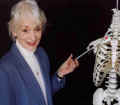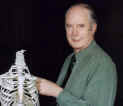 |
 |
 |
Helping You To Achieve ©™

![]()
Helping You To Achieve ©™
|
|
Mark with a surface marking pen the line of the Carpo-Metacarpal joint of the Thumb in the Anatomical Snuffbox on a model in the Anatomical position with a time limit of one minute.
Objective No 25 - Criteria to be demonstrated. 1. Identify and mark the Styloid process of the Radius. (Objective No 12) 2. Identify and mark the anterior projection of the Scaphoid bone. (Objective No 19) 3. Palpate and mark the lateral projection of the Scaphoid bone in the Anatomical Snuffbox between the tendons of Extensor Pollicis Longus and Brevis (Objectives Nos 63 and 64 ). 4. Palpate and mark the lateral projection of the Trapezium bone distal to the Scaphoid in the Anatomical Snuffbox 5. Palpate the prominent Base of the First Metacarpal bone immediately distal to the Trapezium in the Anatomical Snuffbox 6. Place the tip of the palpating finger on the Trapezium and Base of the First Metacarpal bone. 7. Request the model to fully flex and extend the Thumb while maintaining the position of the palpating finger tip in the Anatomical Snuffbox (Step 6). 8. Detect the gliding movement at the joint between the Trapezium and Base of the First Metacarpal bone of the Thumb and mark the joint line in the floor of the Anatomical Snuffbox.
|
Service ProvisionBronze. Students may take up a ,'Free start up ' package consisting of 100 of the behavioural objectives and criteria based on common questions asked in Living Anatomy. These are available free of charge on this Website. Silver. Students may buy a copy of the book "Surface and Living Anatomy" (ISBN: 0 7234 3261 9) which comes with a CD Rom (Windows PC format) containing 230 objectives which includes the 100 behavioural objectives contained in the Bronze Service. Gold "Helping you to Achieve" Contact Information
|